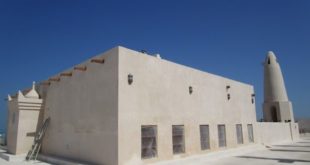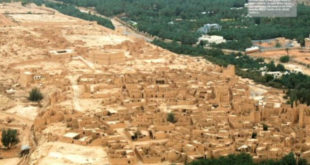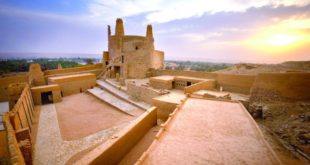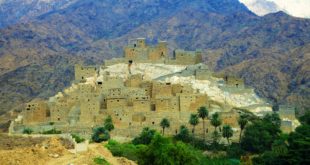Cultural heritage
B- Element:
Prepare
Qatar – Qatar Museums
B- legal status:
The building is considered owned and protected under the Antiquities Law of the State of Qatar promulgated by Law No. 2 of 1980 and all its amendments..
A restored ancient mosque is included in the list of ancient mosques in the Sultanate of Oman and is protected under the Cultural Heritage Protection Law- Who is responsible:
Qatar Museums - Ministry of Municipality and Environment.
The old palace is considered one of the most important archaeological buildings in the State of Qatar, in terms of its distinctive construction style and architectural design, and its richness in decorative and architectural elements that reflect the distinctive style of Qatari local architecture in all its architectural vocabulary. (Construction method, pointed arches, stucco decorations, merlons, lunettes, ceilings). The palace consists of several adjacent buildings. The general plan of the old palace, with its total buildings, is in the form of an unequal rectangle as a central area surrounded by all facilities. It consists of several sections distributed as follows:: The house of Sheikh Abdullah bin Jassim - the house of Sheikh Hamad bin Abdullah - the house of Sheikh Ali bin Abdullah - the middle inner majlis, which consists of two floors - the official majlis in the northeastern corner - the small inner majlis - the northern gate - the eastern gate - the southern gate - the guard’s house.
B- Which includes niches with arches and columns on either side, surrounded by panels carved or elaborately molded from stucco.:
https://drive.google.com/drive/folders/16kF0c8cFFKlxUEYMdq2cNRpjRPGs_kkW?usp=sharing
A restored ancient mosque is included in the list of ancient mosques in the Sultanate of Oman and is protected under the Cultural Heritage Protection Law- Photographic documents and/or films
https://drive.google.com/drive/folders/1lc0hPiZ2FF2H3ix53jAfYMrh8ET8_Wzy?usp=sharing
Sheikh Abdullah bin Bashir bin Muhammad Al-Saqri used to hold teaching sessions on the principles of jurisprudence, the sciences of belief, and the principles of rulings at the Shawadnah Mosque in the winter.- Which includes niches with arches and columns on either side, surrounded by panels carved or elaborately molded from stucco.:
The palace is one of Doha's most famous heritage landmarks, which refers to the ancient lifestyle in the State of Qatar. It is an amazing heritage landmark that celebrates the history and heritage of Qatar and at the same time reflects the progress and rapid development of the state. The palace has unique historical importance for the State of Qatar, as it was built by Sheikh Abdullah bin Jassim. Bin Mohammed Al Thani, the ruler of Qatar at the time in the early twentieth century, and he used it at that time as a headquarters for both residence and government. The palace remained inhabited for more than 15 years, and then it was completely abandoned after that. His Highness the Father Emir Sheikh Khalifa assumed power in February 1972. He issued his generous orders to restore and rehabilitate the palace to become a state museum. In 1975, after its rehabilitation, the palace was transformed into the headquarters of the former Qatar National Museum, and at that time it included a group of artifacts and exhibits that celebrated the Qatari heritage, culture, and environment. In 2013 The restoration and rehabilitation of the palace began for the second time, as it constitutes an important part and section within the design of the modern National Museum.. Currently, the palace occupies a distinguished place in the heart of the new National Museum, and is considered an amazing architectural icon that celebrates the past and embraces the future..
E- Sheikh Abdullah bin Bashir bin Muhammad Al-Saqri used to hold teaching sessions on the principles of jurisprudence, the sciences of belief, and the principles of rulings at the Shawadnah Mosque in the winter.:
Archives of the Architectural Conservation Department at Qatar Museums. The book Traditional Architecture in the State of Qatar, by the author Muhammad Jassim Al-Khulaifi.
The building is currently in use, as part of the modern National Museum of the State of Qatar. It is fully restored and in excellent condition, and is under constant monitoring to carry out regular maintenance if necessary..
B- Responsible for conservation / preservation:
Qatar Museums.
A restored ancient mosque is included in the list of ancient mosques in the Sultanate of Oman and is protected under the Cultural Heritage Protection Law- Stages of conservation / preservation:
Completely restored and in excellent condition, it is under constant supervision for regular maintenance if necessary.
Sheikh Abdullah bin Bashir bin Muhammad Al-Saqri used to hold teaching sessions on the principles of jurisprudence, the sciences of belief, and the principles of rulings at the Shawadnah Mosque in the winter.- Means of conservation / preservation:
All the restoration and rehabilitation work that took place on the palace and its various uses, from the home of the ruler of Qatar, the seat of government, and the old headquarters of the old National Museum, and as an important part of the new National Museum of the State of Qatar, still maintains all its main parts and sections, and its architectural and decorative elements, according to its old construction style and using the same original building materials..
E- Management and/or action plans:
Permanent follow-up and monitoring to carry out periodic maintenance work to avoid the impact of moisture and salts on the building as a result of the high groundwater level due to its proximity to the sea.. To prevent the spread of termite colonies due to moisture.
 Google+
Google+




